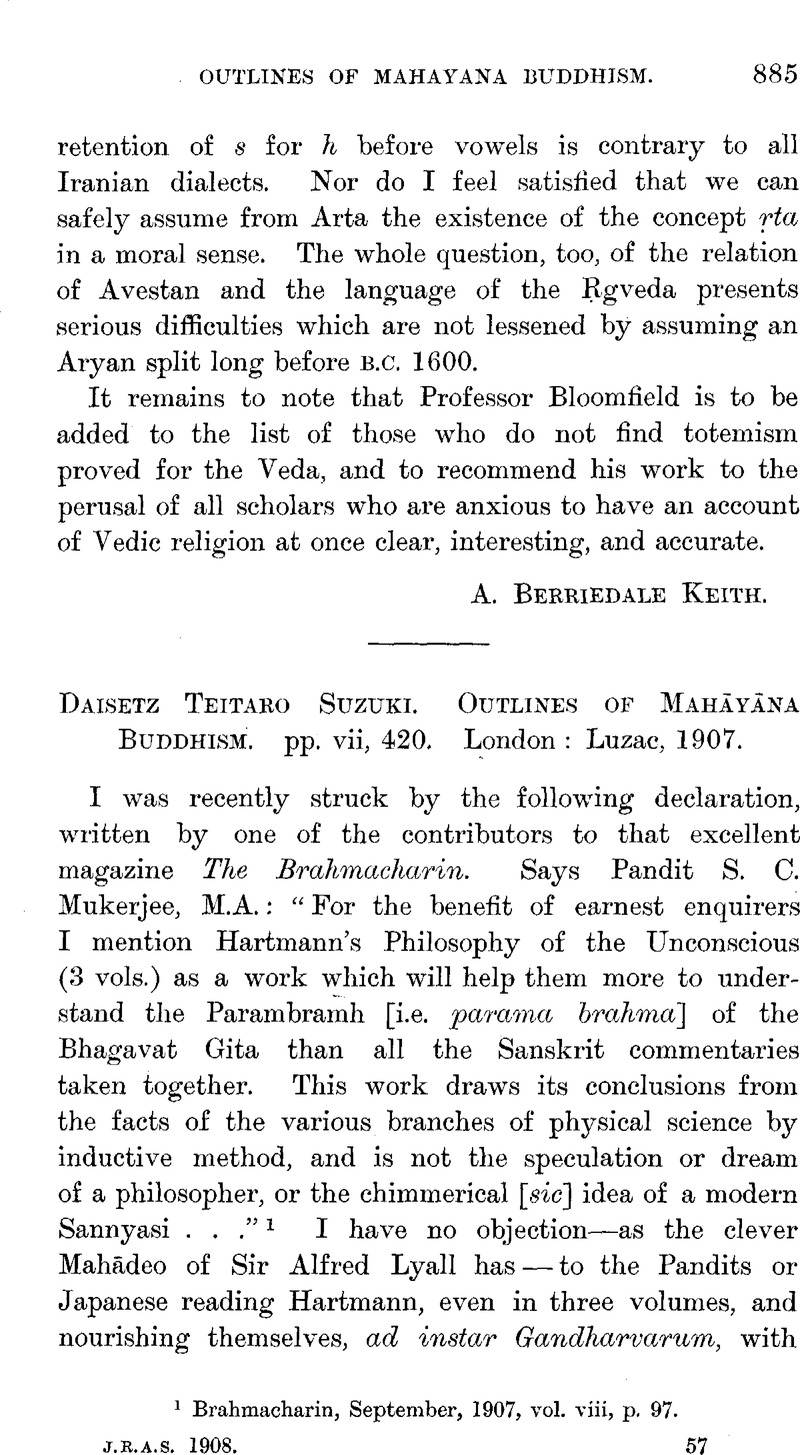No CrossRef data available.
Article contents
Daisetz Teitaro Suzuki. Outlines of Mahāyāna Buddhism, pp. vii, 420. London: Luzac, 1907.
Published online by Cambridge University Press: 15 March 2011
Abstract

- Type
- Notices of Books
- Information
- Copyright
- Copyright © The Royal Asiatic Society 1908
References
page 885 note 1 Brahmacharin, , September, 1907, vol. viii, p. 97.Google Scholar
page 886 note 1 I confess I am rather sensitive when absurd comparisons are made between Christianity and Buddhism, between the “pain de la pensée occidentale,” as says A. Barth, and the “narcotique” of the Bhikṣus. Against my friend Albert J. Edmunds, I would affirm that the “Lamb” of the Apocalypse is a better symbol than the “elephant” of the Lalitavistara: this last animal is not as kind and blameless as A. J. E. believes. Teitaro Suzuki, like his master in philosophy, Dr. Paul Carus, is very hard upon the “Christian critics” of Buddhism (p. 18). Everybody, I think, will admit that Colonel Waddell has rightly characterised Mahāyānism by the following phrase, “a mysticism of sophistic nihilism.” Christian prejudices have no part in this opinion. But T. Suzuki feels indignant: “Could a religious system be called sophistry when it makes a close enquiry into the science of dialectics, in order to show how futile it is to seek salvation through the intellect alone?” Even if such were the case, the dialectical enquiry of the Buddhist is not only sophistic but nonsensical throughout. For instance, Nāgārjuna says that the walker (the man who is walking) is not walking, because two “walks” would be necessary—a first owing to which he is named “walker,” a second owing to which the walker walks. Sophistry is not the exact name for such jokes: stupidism would do. T. Suzuki says again: “Could a doctrine be called nihilistic when it defines the absolute as neither void nor notvoid?” I think that the Buddhists absolutely deny the existence of an absolute, or, rather, say that “truth is silence.” But, even if we accept Suzuki's opinion, Colonel Waddell's definition would prove excellent: is it not “mystic nihilism” to find a via media between “being” and “nonbeing”? Monier-Williams was a good scholar, “but, unfortunately, as soon as he attempts to enter the domain of religious controversy, his intellect becomes piteously obscured by his preconceived ideas. … Bodhisattvas … are contented, according to his view, with their ‘perpetual residence in the heavens, and quite willing to put off all desires for Buddhahood and Parinirvāṇa.’ This remark is so absurd that it will at once be rejected … as … unworthy of refutation.” Suzuki then quotes very sensible lines of Monier-Williams on the “celestial regions” and the “dreamy bliss in Heaven,” which play an important role in Amitābha's worship. But Suzuki has supercilious marks of amazement, (!) (!), and the reader will feel sure that the Sukhāvatīvyȳha, the Kāraṇḍavyūha, the Lotus of the Good Law, and many other sūtras are terra incognita to our Outliner of Mahāyāna; he seems to believe that the devaloka is the only heaven of the Mahāyāna.
page 888 note 1 Aśvaghosha's, “Awakening of Faith in the Mahāyāna” (Chicago, Open Court, 1900), p. 146.Google Scholar
page 888 note 2 For instance: p. 171, sarvam dharmam niḥsvabhāvam, pratyayasamutpāda, vyatirekena and vyatireṇa; p. 172Google Scholar, tat tac śantam—“Says Piṅgalaka …” This Piṅgalaka is the so-called Nīlacakṣus, alias Nīlanetra or Piṅgalanetra (°akṣa) or Āryadeva of Nanjio. His true name is Bhāvaviveka or Bhāviveka (?) according to Watters: p. 173, aniyata, rather anitya, which cannot be a synonym for pratītya.
page 890 note 1 Sic Bendall; rather °uttāraṇe pra°.
page 890 note 2 na viṣīdāmī; has the Chinese translator read pramāda?
page 891 note 1 But the brackets are wanting at p. 298, 1, where is celebrated “the universal love of the Dharmakāya.”
page 891 note 2 The Prajñāpāramitā, the mother of the Bodhisattvas, and also the çakti of the Tāntrik Buddhas, is not bodhicitta.
page 892 note 1 Laṅkāvatāra, , pp. 80–81Google Scholar (Buddhist Text Society). Let us observe, en passant, that T. Suzuki is unfortunate enough to make worse the already disastrous reading of this edition. I hear that Mr. Sakaki is preparing an edition of this important text. According to Mahāyāna, we are Buddhas because (1) we can become Buddhas; (2) in absolute truth, we do not exist, and the Buddhas too are only names, therefore the Buddhas and all the beings are identical according to the logical argument a = c, b = c, a = b. In the same way saṁsāra is void, nirvāṇa is void, ergo saṁsāra = nirvāṇa. So far the Mādhyamikas. The Vijñānavādins go a little further. There is only ‘thought,’ without object, subject, and act of thinking. The Buddhas have dispelled all the veils that envelop the ‘absolute thought’: we have not. Monist or pantheistic speculations may grow on this principle, and such has been the case.




